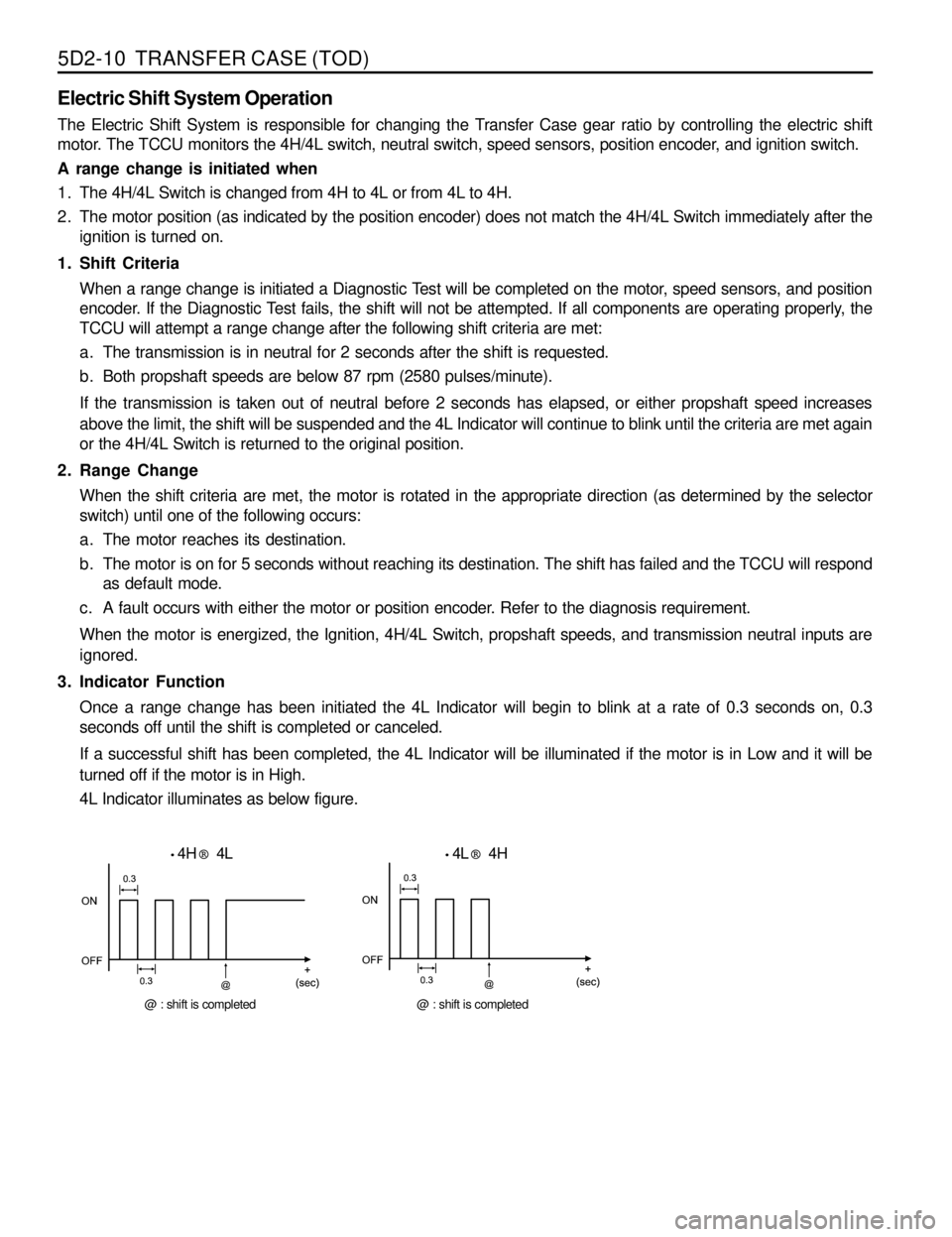1998 SSANGYONG MUSSO ECO mode
[x] Cancel search: ECO modePage 1037 of 1463

5A-60 AUTOMATIC TRANSMISSION
DIAGNOSIS
DIAGNOSTIC SYSTEM
Recommended Test Equipment and Procedure
The test equipment is designed to be used with the control modules in all vehicles. The components used in the
transmission application are:
lMulti Function Tester, and
lAppropriate vehicle for testing.
Multi Function Tester (MFT)
The MFT is programmed with the special vehicle diagnostic software that allows selection of the unit under test.
The program allows the proper communication to the Transmission Control Unit (TCU).
It then requests information from the user via a menu system to select the required set up.
Examples are viewing codes, clearing error codes, and real-time operation. Set up and operation instructions are
detailed in the user manual.
This equipment can be used by trained personnel such as technicians and mechanics to diagnose electronic and
wiring problems relating to the vehicle transmission. Information that is available includes engine and road (shaft)
speed, transmission oil temperature, throttle position, solenoid/gear status and gear lever position. Current and
stored faults detected by the electronics are also available.
TCU Pin Description
The TCU pin descriptions are listed in table 6.1.1.
The wiring loom pins are shown in figure 6.1.1
Pin
No.
1
2
3
4
5
6
7
8Identification
Common Ground
Do not use
Mode Indicator Lamp -
‘Winter’
Gear Position ‘Park’
Lamp
Gear Position ‘Reverse’
Lamp
Gear Position ‘Neutral’
Lamp
Do not use
Engine Speed Input
Sensor (-Ve)Type
GND
-
OP
OP
OP
OP
-
IPDescription
Main power ground (or the module. Connects
directly to the battery negative terminal.
Indicates ‘WINTER’ mode shift schedule is se-
lected.
Drives the jewel in the instrument cluster to in-
dicate ‘PARK’ gear lever position.
Drives the jewel in the instrument cluster to in-
dicate ‘REVERSE’ gear lever position.
Drives the jewel in the instrument cluster to in-
dicate ‘NEUTRAL’ gear lever position.
Flywheel/Ring gear pulses to indicate engine
speed. 4WD
(Diesel)
O
O
l
l l l
l
4WD
(Gas)
O
O
O
l
l l l
l
l
Table 6.1.1 - TCU Pin Description
Page 1041 of 1463

5A-64 AUTOMATIC TRANSMISSION
Default Transmission Operating Modes
The TCU relies on accurate information from its inputs and complete control of its outputs to effectively control the
transmission. To ensure that it has both valid inputs and functioning outputs, the TCU carries out both hardware and
software fault detection routines. The TCU will respond to any faults detected by adopting the operating modes which
are detailed below.
The following symptoms of faults are the most obvious results of each fault under ‘normal’ conditions.
There is always the possibility that a fault may not be detected. If undetected fault conditions are present, the
operation of the transmission is difficult to predict.
1 Throttle Fault
lAll shifts will occur as if a nominal throttle (approx. 44%) were applied for shift scheduling.
lAll shifts will be firm as full throttle and hence high engine torque is assumed.
lThe torque converter will be unlocked at all times.
lAll downshifts initiated by the shift lever will occur as though they were ‘automatic’ shifts. That is the engine
braking effect will not occur until near the end of the shift.
lLine pressure will always stay high (solenoid 6 OFF) to cope with assumed high throttle/torque.
If a fault is undetected, the percent throttle is most likely to be interpreted as higher than actual, resulting in late
upshifts, early downshifts, firm shifting and a harsh 3-1 shift when stopping.
2 Throttle Not Learnt Fault
The transmission operates from default throttle calibration values which results in the evaluation of the throttle being
higher (more open) than it is. There(ore at zero throttle settings, the transmission may calculate that sufficient throttle
opening is present to justify high line pressure and switch solenoid 6 to OFF.
Other symptoms are:
a. late upshifts and
b. lock-up maintained at zero throttle when the vehicle speed is sufficiently high.
3 Engine Speed Fault
lAll shifts will be firm because an engine speed corresponding to peak engine torques is assumed.
If a fault is undetected, the engine speed is likely to be interpreted as stalled resulting in soft shifting possibly with an
end of shift bump.
4 Vehicle Speed Sensor Fault
lAll shifts will be controlled by the shift lever with skip downshifts disabled and downshifts only allowed if the
engine speed is low. Fourth gear will be inhibited.
lThe torque converter will be unlocked at all times.
If a fault is undetected, the vehicle is likely to be interpreted as being stationary resulting in first gear operation at all
times. Note that speedometer transducer faults are likely to cause the vehicle’s speedometer to become inoperative.
5 Gear Lever Fault (Inhibitor/PRNDL Switch)
lThe gear lever is assumed to be in the Drive position.
lThe transmission is limited to 2nd,3rd, and R gears only.
lThe rear band will apply at all times when the lever is shifted to P, R or N. (B2 inhibition and reverse lockout
protection is disabled.)
lThe torque converter will be unlocked at all times.
lManually (gear lever) initiated downshifts will not be available.
If a fault is undetected, the gear lever position is likely to be interpreted as being higher than actual. Where Park is the
highest position and Manual 1 is the lowest, the result being the availability of higher gears than selected by the gear
lever.
Page 1042 of 1463

AUTOMATIC TRANSMISSION 5A-65
If the gear lever is incorrectly adjusted, the transmission may shift gears on bumpy road surfaces.
6 Transmission Oil Temperature Sensing Fault
lAll shifts will be firm until the transmission has warmed up, because a high transmission oil temperature is
assumed.
If a fault is undetected, the temperature is likely to be evaluated as being lower than actual, resulting in softer shifts
with ‘end bump’ (very firm feel at the end of the shift).
7 Mode Setting Fault
lAll shifts will occur as if the mode is set to ‘NORMAL’.
lThe mode indicator will always be off indicating that ‘NORMAL’ mode is selected.
lThe mode indicator will not respond to changes in switch setting.
If a fault is undetected, the mode as indicated by the mode indicator is not likely to respond to the mode switch.
8 Battery Voltage Sensing Fault
If the battery voltage is low then shifts to first gear are inhibited.9 the battery voltage is high (>16.5V) then the
transmission goes into limp home (LHM) mode.
If a fault is undetected, the transmission is likely to incorrectly evaluate an ON/OFF solenoid fault resulting in limp
home mode (LHM) operation.
9 ON/OFF Solenoid Fault (Solenoids 1,2,3 and 4)
The transmission adopts its limp home mode (LHM) operation, described above. However, if solenoid 1 is faulty then
the fourth gear LHM strategy will be adopted independent of vehicle speed.
If a fault is undetected, the operation of the transmission is dependent on which solenoid is actually faulty. The
characteristics for different solenoid fault conditions are listed in table 6.1.2.
10 ON/OFF Solenoid Fault (Solenoids 6,7)
If solenoid 6 is found faulty it is always disabled resulting in high line pressure being applied continuously.
If solenoid 7 is found faulty it is disabled resulting in the transmission being locked always.
The transmission does not go into LHM.
11 Variable Pressure Solenoid Fault
The transmission adopts its LHM operation.
If a fault is undetected, the transmission shift feel is likely to be poor for all shifts.
12 Software Fault
The transmission adopts the third gear LHM strategy of operation, independent of vehicle speed. The operation of
the TCU under this condition is difficult to predict. Its operation may be erratic.
If a fault is undetected, the operation of the TCU is likely to be erratic.
13 Power Supply Fault
The transmission adopts the third gear LHM strategy of operation, independent of vehicle speed. If there is an
intermittent power supply connection, the TCU will power-up in fourth gear and then shift to the appropriate gear to
satisfy the conditions present. The power supply is not monitored for fault evaluation.
All faults except for solenoid faults can be recovered without having to turn the TCU off and back on. However, in
general the recovery requires that no faults are present for a period of time (approx. 3 or 30 seconds). Recovery from
a fault will not clear the fault from the keep alive memory
14 Transmission Sump Temperature Exceeding 135°C
lThe converter lockup clutch will be applied at lower speeds, causing a shudder through the vehicle.
lThe mode indicator will flash in some vehicles.
These faults can be due to the transmission oil overheating or due to an incorrect signal received from the temperature
sensor.
Page 1045 of 1463

5A-68 AUTOMATIC TRANSMISSION
Description / Cause
The signal from the mode switch is unreliable.
This fault is caused by too many changes in the mode input signal
over a period of time. Typical causes would be an intermittent connec
tion in the switch or wiring or an intermittent short to ground in the
wiring.
The data link between the TCU and the engine management module
is found to be unreliable because the checksum, or the data received,
did not match the correct checksum.
This could be caused by an open circuit, short circuit to ground or a
loose connection in the link wire itself.
Each solenoid in turn is switched off if it was energised, or switched on
if it was not energised by a very small 100 ms pulse. This pulse is too
short for the solenoid to react so transmission operation is not af
fected.
The solenoid feedback voltage is measured before the 100 ms pulse
and again during the pulse. If the difference is outside the acceptable
limits the relevant fault messages are set.
Typical causes would be an open circuit in the wiring to or within the
solenoid, or a short circuit to ground in the wiring to, from or within the
solenoid in question.
If several of these fault codes are presents check the wiring or
connectors that are common to the selected solenoids, especially the
earth connections.
The state of the solenoid feedback voltage is outside acceptable
limits but the faulty solenoid could not be isolated.
The current to solenoid 5 was outside acceptable limits.
This fault results from a mismatch between the current set point for
solenoid 5 and the current measured by the feedback within the TCU.
Typical causes would be an open circuit or short circuit to ground in
the wiring to, from or within the solenoid. It is also possible that there
has been a fault in the solenoid output circuit. If this is the case
however, the fault should be continually present.
The closed throttle position has not been learnt. This fault
may be caused by the transmission not having reached normal
operating temperature or the engine idle speed being incorrect.
The TCU will learn the closed throttle position automatically
when the transmission is brought to normal operating
temperature and the engine is allowed to idle in Drive with the
‘base idle’ correctly set and the air conditioner (if fitted)
switched off. Condition
Mode Switch Input Fault
(Power/Economy Mode)
Data Output Link Fault
On/off Solenoid Fault
(Solenoid 1,2,3,4,6,7)
Solenoid 5 Fault
(Variable Pressure
Solenoid)
Throttle Not LearntSolenoid
9
10
11
12
13
Page 1046 of 1463

AUTOMATIC TRANSMISSION 5A-69
MECHANICAL TESTS
In Vehicle Transmission Checks
Carry out the following tests before removing the transmission.
lSee Checking Transmission Fluid Level, Section 7.2.1.
lCheck that the transmission oil is not burnt (colour and smell are correct).
lEnsure that the transmission is not in limp home mode (LHM).
lCheck that the battery terminals and the earth connections are not corroded or loose.
lCheck the engine stall speed is within the handbook value.
lCheck that the cooler flow is not restricted.
lCheck that all electrical plug connections are tight.
lCarry out a road test to confirm the symptoms, if necessary.
lInspect the oil, ensure that there are no metal or other contaminants in the oil pan.
Diagnosing Oil Leaks
Determine the source of oil leaks by firstly cleaning down the affected area, then driving the vehicle.
Inspect the seals to confirm the source of the leak.
lTo determine the source of a rear servo oil leak, raise the vehicle on a hoist, then carry out a reverse stall.
lTo determine the source of a front servo leak, raise the vehicle on a hoist, then run the vehicle in second gear.
Troubleshooting Charts
The troubleshooting charts are set out as follows:
lTable 6.2.1 Drive Faults,
lTable 6.2.2 Faulty Shift Patterns.
lTable 6.2.3 Shift Quality Faults.
lTable 6.2.4 After Teardown Faults.
Table 6.2.1 - Drive Faults
Action
Check the fluid level. Top up as necessary.
Inspect and clean C1/C2 feed.
Reinstall/renew the ‘z’ link.
Remove, clean and re-install the PRV.
Inspect and replace as necessary.
Inspect and replace as necessary.
Inspect and replace as necessary.
Check servo adjustment or replace rear band
as necessary.
Check for failure in C3, C3 hub or C1/C2 cylin-
der. Repair as necessary.
Inspect and clean PRV.
Inspect and replace pump gears as necessary.
Inspect and repair as necessary. Possible Cause
Insufficient auto transmission fluid.
Blocked feed in C1/C2 cylinder.
‘Z’ link displaced.
Primal regulator valve (PRV) jammed open.
Overdrive shaft or input shaft seal rings
failed.
3-4 or 1-2 one way clutch (OWC) installed
backwards or failed.
C2 piston broken or cracked.
Rear band or servo faulty.
Failure in C3, C3 hub or C1/C2 cylinder.
Jammed primary regulator valve (PRV).
Damaged/broken pump gears.
Dislodged output shaft snap ring.Symptom
No Drive in D
No Drive in
Reverse
No engine braking
in Manual 1
Engine braking in
Manual 1 is OK
No drive in Drive
and Reverse
Page 1216 of 1463

TRANSFER CASE (TOD) 5D2-9
4H/4L Switch Input
4H
4H
4H
4H
4H
4H
4H
4H
4H
4L
4L
4L
4L
4L
4L
4L
4L
4L
Position Sensor Interpretation
1. When the module powers up, it will read the position sensor
and the 4H/4L switch input and respond to the possible
codes as follows
2. A command to shift will only be acted upon if the TCCU is
reading a valid code at the time the command to shift is
made.
3. After a shift has started, the TCCU will power the shift motor
until the code for the requested position is read. If an invalid
code is read, the TCCU will go into a default mode.
4. During a shift attempt, the shift motor will be energized for a
maximum of 5 seconds.Motor Position
Left Stop
Left of High
High
Right of High
Zone 1
Neutral
Zone 2
Low
Right Stop
Left Stop
Left of High
High
Right of High
Zone 1
Neutral
Zone 2
Low
Right StopAction
No action required. 4L bulb off.
No action required. 4L bulb off.
No action required. 4L bulb off.
Blink 4L bulb. After the shift conditions are met, attempt a shift
to 4H under conditions of below 87 rpm in front and rear
propshaft and “Neutral” position. After succesfully shifting into
4H, stop blinking 4L bulb.
Same as above
Same as above
Same as above
Same as above
Same as above
Blink 4L bulb. After the shift conditions are met, attempt a shift
to 4L. After succesfully shifting into 4L, stop blinking 4L bulb.
Same as above
Same as above
Same as above
Same as above
Same as above
Same as above
No action required. 4L bulb on.
No action required. 4L bulb on.
Page 1217 of 1463

5D2-10 TRANSFER CASE (TOD)
Electric Shift System Operation
The Electric Shift System is responsible for changing the Transfer Case gear ratio by controlling the electric shift
motor. The TCCU monitors the 4H/4L switch, neutral switch, speed sensors, position encoder, and ignition switch.
A range change is initiated when
1. The 4H/4L Switch is changed from 4H to 4L or from 4L to 4H.
2. The motor position (as indicated by the position encoder) does not match the 4H/4L Switch immediately after the
ignition is turned on.
1. Shift Criteria
When a range change is initiated a Diagnostic Test will be completed on the motor, speed sensors, and position
encoder. If the Diagnostic Test fails, the shift will not be attempted. If all components are operating properly, the
TCCU will attempt a range change after the following shift criteria are met:
a. The transmission is in neutral for 2 seconds after the shift is requested.
b. Both propshaft speeds are below 87 rpm (2580 pulses/minute).
If the transmission is taken out of neutral before 2 seconds has elapsed, or either propshaft speed increases
above the limit, the shift will be suspended and the 4L Indicator will continue to blink until the criteria are met again
or the 4H/4L Switch is returned to the original position.
2. Range Change
When the shift criteria are met, the motor is rotated in the appropriate direction (as determined by the selector
switch) until one of the following occurs:
a. The motor reaches its destination.
b. The motor is on for 5 seconds without reaching its destination. The shift has failed and the TCCU will respond
as default mode.
c. A fault occurs with either the motor or position encoder. Refer to the diagnosis requirement.
When the motor is energized, the Ignition, 4H/4L Switch, propshaft speeds, and transmission neutral inputs are
ignored.
3. Indicator Function
Once a range change has been initiated the 4L Indicator will begin to blink at a rate of 0.3 seconds on, 0.3
seconds off until the shift is completed or canceled.
If a successful shift has been completed, the 4L Indicator will be illuminated if the motor is in Low and it will be
turned off if the motor is in High.
4L Indicator illuminates as below figure.
· 4H ® 4L
@ : shift is completed
· 4L ® 4H
@ : shift is completed
Page 1218 of 1463

TRANSFER CASE (TOD) 5D2-11
4. Electric Shift Default Mode
If the motor fails to reach its destination, the TCCU will attempt the following (in order):
a. The TCCU will wait 3 seconds then attempt the shift again.
b. If the second attempt to reach the destination fails the TCCU will wait 3 seconds then attempt to rotate the
motor back to the original position. If successful, all future shifts will be inhibited until the Ignition is cycled.
c. If the attempt to return to the original position fails, the TCCU will wait 3 seconds then attempt to rotate the
motor to the original position again. If the second attempt to return to the original position is successful, the
“4WD CHECK” lamp will be illuminated, and all future shifts will be inhibited until the Ignition is cycled.
d. If the second attempt to return to the original position fails the motor will be turned off, the “4WD CHECK” lamp
will be illuminated, and all future shifts will be inhibited until the Ignition is cycled.
TODTM System Operation
The TODTM System is responsible for distributing torque between the front and rear axles. The TCCU monitors the
propshaft speeds, operating range (High/Low), and ABS activity and then applies a calculated amount of torque to
the front axle by Pulse Width Modulating the current applied to the EMC.
1. Touch-off Torque
The minimum EMC Duty Cycle is based on the vehicle speed and throttle position
The TCCU receives the TPS signal from the following sources:
On vehicles equipped with CAN, the TCCU receives the TPS signal from the CAN bus.
2. When Slip Detection
The TCCU continuously monitors the front and rear propshaft speeds to detect wheel slip.
3. Wheel Slip Control
When wheel slip is detected the TCCU controls the EMC duty cycle as necessary until the wheel slip is reduced
below the allowable limit. The EMC Duty Cycle will then be reduced to the Touch-Off value.
4. Brake/ABS Strategy
When the ABS System is active, the EMC Duty Cycle is set to a fixed duty cycle (30%) to aid in braking without
counteracting the ABS System.
5. 4L Strategy
When the system is operating in 4L, the TCCU continues TOD
TM (operation provided that the propshaft speed is
below 175 rpm (5220 pulses/minute)). When the speed increases above 175 rpm, the EMC Duty Cycle is set to
the maximum value (88%) which applies the maximum available torque to the front axle.